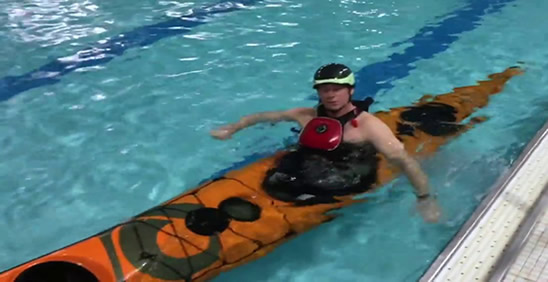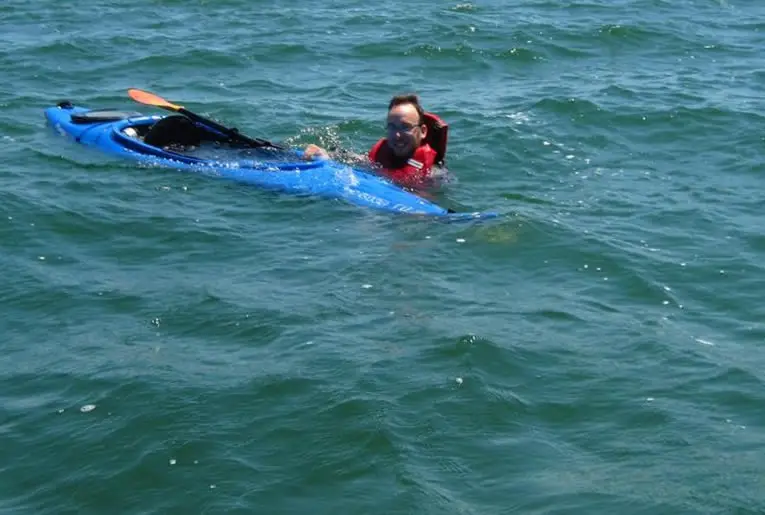Most whitewater river kayaks have Styrofoam bolted in place at the bow and stern to give the boat extra buoyancy should it capsize. The foam will help the boat float at the water waterline making it easier to retrieve if it sinks. The foam also helps protect the kayaker’s legs from injury in the event the hull takes a serious knock and starts to buckle inward.
Contents
Why add Styrofoam to a kayak?
Having Styrofoam in your kayak can be a bit annoying for some paddlers. In fact, it can sometimes be downright uncomfortable.
Having to straddle a large piece of foam just to sit in your boat can be a pain. So, can you just whip it out and carry on paddling like nothing was ever there?
Well, the answer to that question depends on how you want to use your kayak and how attached you are to it.
River kayaking
Not all kayaks have foam fitted in them. Sit-on-top kayaks have none at all, but not even all sit-in kayaks have foam in them. To understand why this is, we need to look at why foam is added to a kayak and the important functions it offers the paddler.
Most kayaks that have Styrofoam in them are whitewater kayaks because these particular types of kayak are more susceptible to taking on water and sinking simply because of the type of activities whitewater kayaks are used for.
Whitewater kayaks, also known as river kayaks, are used for river running.
River running can be a dangerous activity especially when the rivers have higher class whitewater and rapids. Only certain types of boats, such as river rafts, drift boats and some canoes, are capable of navigating up to class IV whitewater rivers and only rafts and whitewater kayaks can be used on class V and VI whitewater rivers.
Adding foam to a kayak helps to offset the many dangers associated with this type of kayaking activity.
Let’s look at how this works.
Kayak recovery
Just as adding foam to a boat will have zero affect on its buoyancy while it is on the water, adding foam to a kayak will not help it float better while you are paddling in it either. However, adding foam to a boat does have a very important affect on the boat’s buoyancy if it takes on water and starts to sink.
Styrofoam, or any other buoyant material, in a boat has no effect on its buoyancy while it is on the water. In fact, it actually adds to the weight of the boat making it less buoyant, albeit almost imperceptibility.
However, if your boat ends up filled with water and starts to sink, the foam will act as a buoyancy aid to stop it sinking to the bottom, in the same way a good quality PFD does for the paddler, thus keeping the boat afloat just beneath the waterline.

This is an important moving-saving feature as many kayaks are expensive. Kayaks can be easily lost in turbulent water if they take on too much water and are carried away to deeper parts of the river where they can sink to the bottom.
Having a kayak stay just below the waterline makes it much easier to retrieve the boat. But, being able to retrieve a capsized kayak if you are thrown from it in whitewater is not only a money-saving feature, it could be an essential safety feature if you need to hold onto the kayak to stay afloat yourself.
But, this is not the only safety feature Styrofoam offers the river running kayaker.
Essential safety against leg injuries and drowning
Styrofoam packed inside the hull of a whitewater kayak offers a great deal of additional safety to the paddler.
As I’m sure you are already well aware of the fact that whitewater kayaking can get very physical. The kayak can be battered about quite a bit in rapids and can be involved in some serious collisions with rocks and boulders.
Most modern whitewater kayaks are made from tough rotomolded plastic that is designed to take some serious abuse. However, even this tough type of plastic has its limits. Even the much more expensive carbon Kevlar kayaks, that are much tougher than their plastic cousins, can take damage in turbulent rapids.
With whitewater kayaks being used frequently in class V rapids, and even in Class VI rapids when the conditions are right, you must expect the boat to get knocked around a lot. Heavy knocks against rocks and boulders in fast moving water is more than enough to seriously dent even the toughest of kayaks.
Styrofoam is added to the kayaks to help avoid serious injury to the paddler that would be caused if the hull buckled in one itself and against the kayaker’s legs. Additionally, the foam also limits the risk to the paddler of getting stuck in the kayak and being unable to get out if the kayak hull where to buckle so far inwards that it trapped the paddler’s legs.
Styrofoam can greatly help to reinforce the hull against such shock impacts which would normally dent the hull significantly enough to cause injury or prevent exist form the kayak. This could be life-threatening if the kayak gets caught in a roll in rapids. With the paddler stuck inside and unable to exit the kayak drowning is a real possibility.
Luckily, the Styrofoam at the bow and stern of the kayak will help brace the hull against such impacts preventing denting from occurring, by giving the hull just enough reinforcement to limit the damage caused by large impacts. The boat may well bear the scars of the encounter but your legs won’t!
Should I remove the foam from my kayak?
If you have Styrofoam in your kayak then you likely have a whitewater kayak. If you have a whitewater kayak then the chances are you intend to use it in rivers. Rivers can be turbulent and whitewater kayaks are designed to handle whitewater and rapids. They need foam in them for safety reasons.
However, if you never plan to use your kayak in those environments, or have bought a different type of used kayak that has foam in it, you can remove the foam. I would advise against it though.
Styrofoam adds very little weight to your kayak so it doesn’t affect the handling or the transportation of the boat but it is a very clever safety feature. Why would you want to remove it? In the worst case scenario you will never need it and it will simply sit in your boat being ignored. On the other hand it could help you retrieve your expensive boat if you get separated from it and it sinks. In the best case scenario it could help to save you from serious injury or even death.
If you river run in a kayak do not remove the foam!
As you can see the Styrofoam in a kayak is an essential safety item that can save your kayak and even save your life. Leave it in your kayak.
Can I modify the foam in my kayak?
Obviously, all paddlers are unique and we are all different sizes, different shapes and have slightly different paddling styles. So, the generic placing of foam in a kayak may cause some slight discomfort or affect your overall enjoyment of the kayaking experience.
In cases where the Styrofoam is causing you problems it is perfectly acceptable to modify it slightly to increase your comfort and enhance your paddling performance. It is not advisable to completely remove the foam entirely but you can trim the edges. The foam should not be in the way of your legs as you paddle and removing any foam that restricts your ability to get in and out of the boat can be removed.
Removing bits of the foam that is hindering your ability to kayak correctly is perfectly acceptable. Just don’t remove too much. Remember the foam is there for your protection and it could just save your life!
Should I put foam in my kayak?
Not all kayaks come with factory-fitted foam inside, and some kayakers would like to know if they should add foam to their boats. This is a matter of personal choice and depends greatly on how you intend to use your kayak.
As we have seen, Styrofoam is added to whitewater kayaks as an essential safety feature. Many kayaks that are not used in such dangerous activities therefore do not need the hull reinforcing and type of protection that foam offers the paddler. For example, a recreational flat bottom kayak that is used in still water has little need for foam to be put in it.
However, every type of kayak can sink. So, you may decide to add foam as an additional safety feature and that is perfectly fine to do.
Adding foam to your kayak is a good idea although it will not give it more buoyancy when in use. It the kayak sinks foam will help it float closer to the waterline making retrieval easier and allowing the boat to act as a life-raft. However, you must be careful with the type of foam you put in a kayak. Some types of foam soak up water thus making the boat heavier and forcing it deeper into the water. Some foams can expand with water intake and cause the kayak hull to split.
Cross linked polyethylene foam is a great choice for kayaks for a number of reasons.
Cross linked polyethylene foam characteristics include:
- Extreme buoyancy due to low water permeability. So, no soaking up water or expanding in water.
- Durability and resilience.
- High resistance against bacteria, mold, mildew, and rot.
- Easily absorbs extreme shocks associated with whitewater kayaking. Offers great reinforcement for kayak hulls.
- Nontoxic substance that is manufactured without CFCs, HCFCs, or hydrocarbon blowing agents.

